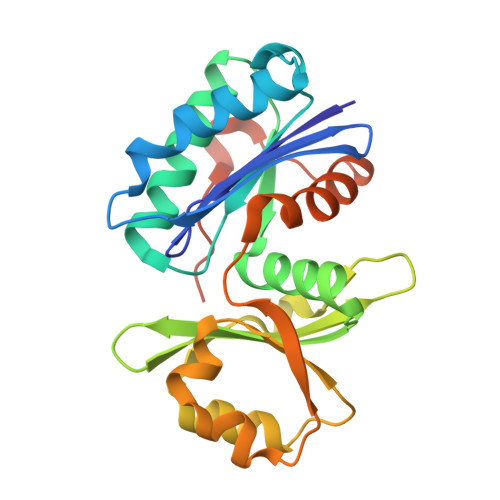Structural Characterization of Salmonella typhimurium YeaZ, an M22 O-Sialoglycoprotein Endopeptidase Homolog
Nichols, C.E., Johnson, C., Lockyer, M., Charles, I.G., Lamb, H.K., Hawkins, A.R., Stammers, D.K.(2006) Proteins 64: 111-123
- PubMed: 16617437
- DOI: https://doi.org/10.1002/prot.20982
- Primary Citation of Related Structures:
2GEL, 2GEM - PubMed Abstract:
The Salmonella typhimurium "yeaZ" gene (StyeaZ) encodes an essential protein of unknown function (StYeaZ), which has previously been annotated as a putative homolog of the Pasteurella haemolytica M22 O-sialoglycoprotein endopeptidase Gcp. YeaZ has also recently been reported as the first example of an RPF from a gram-negative bacterial species. To further characterize the properties of StYeaZ and the widely occurring MK-M22 family, we describe the purification, biochemical analysis, crystallization, and structure determination of StYeaZ. The crystal structure of StYeaZ reveals a classic two-lobed actin-like fold with structural features consistent with nucleotide binding. However, microcalorimetry experiments indicated that StYeaZ neither binds polyphosphates nor a wide range of nucleotides. Additionally, biochemical assays show that YeaZ is not an active O-sialoglycoprotein endopeptidase, consistent with the lack of the critical zinc binding motif. We present a detailed comparison of YeaZ with available structural homologs, the first reported structural analysis of an MK-M22 family member. The analysis indicates that StYeaZ has an unusual orientation of the A and B lobes which may require substantial relative movement or interaction with a partner protein in order to bind ligands. Comparison of the fold of YeaZ with that of a known RPF domain from a gram-positive species shows significant structural differences and therefore potentially distinctive RPF mechanisms for these two bacterial classes.
- Division of Structural Biology, The Wellcome Trust Centre for Human Genetics, University of Oxford, Oxford, United Kingdom.
Organizational Affiliation:
















